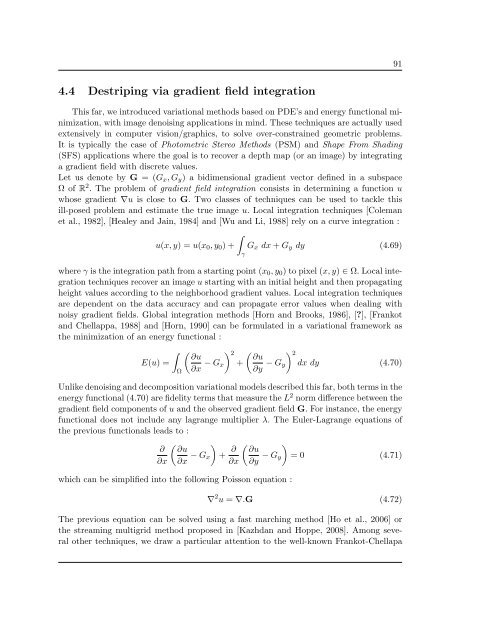Th`ese Marouan BOUALI - Sites personnels de TELECOM ParisTech
Th`ese Marouan BOUALI - Sites personnels de TELECOM ParisTech
Th`ese Marouan BOUALI - Sites personnels de TELECOM ParisTech
You also want an ePaper? Increase the reach of your titles
YUMPU automatically turns print PDFs into web optimized ePapers that Google loves.
91<br />
4.4 Destriping via gradient field integration<br />
This far, we introduced variational methods based on PDE’s and energy functional minimization,<br />
with image <strong>de</strong>noising applications in mind. These techniques are actually used<br />
extensively in computer vision/graphics, to solve over-constrained geometric problems.<br />
It is typically the case of Photometric Stereo Methods (PSM) and Shape From Shading<br />
(SFS) applications where the goal is to recover a <strong>de</strong>pth map (or an image) by integrating<br />
a gradient field with discrete values.<br />
Let us <strong>de</strong>note by G =(G x ,G y ) a bidimensional gradient vector <strong>de</strong>fined in a subspace<br />
Ω of R 2 . The problem of gradient field integration consists in <strong>de</strong>termining a function u<br />
whose gradient ∇u is close to G. Two classes of techniques can be used to tackle this<br />
ill-posed problem and estimate the true image u. Local integration techniques [Coleman<br />
et al., 1982], [Healey and Jain, 1984] and [Wu and Li, 1988] rely on a curve integration :<br />
∫<br />
u(x, y) =u(x 0 ,y 0 )+ G x dx + G y dy (4.69)<br />
where γ is the integration path from a starting point (x 0 ,y 0 ) to pixel (x, y) ∈ Ω. Local integration<br />
techniques recover an image u starting with an initial height and then propagating<br />
height values according to the neighborhood gradient values. Local integration techniques<br />
are <strong>de</strong>pen<strong>de</strong>nt on the data accuracy and can propagate error values when <strong>de</strong>aling with<br />
noisy gradient fields. Global integration methods [Horn and Brooks, 1986], [], [Frankot<br />
and Chellappa, 1988] and [Horn, 1990] can be formulated in a variational framework as<br />
the minimization of an energy functional :<br />
∫<br />
E(u) =<br />
Ω<br />
γ<br />
( ) ∂u 2 ( ) ∂u 2<br />
∂x − G x +<br />
∂y − G y dx dy (4.70)<br />
Unlike <strong>de</strong>noising and <strong>de</strong>composition variational mo<strong>de</strong>ls <strong>de</strong>scribed this far, both terms in the<br />
energy functional (4.70) are fi<strong>de</strong>lity terms that measure the L 2 norm difference between the<br />
gradient field components of u and the observed gradient field G. For instance, the energy<br />
functional does not inclu<strong>de</strong> any lagrange multiplier λ. The Euler-Lagrange equations of<br />
the previous functionals leads to :<br />
∂<br />
∂x<br />
( ∂u<br />
∂x − G x<br />
which can be simplified into the following Poisson equation :<br />
)<br />
+ ∂ ( ) ∂u<br />
∂x ∂y − G y = 0 (4.71)<br />
∇ 2 u = ∇.G (4.72)<br />
The previous equation can be solved using a fast marching method [Ho et al., 2006] or<br />
the streaming multigrid method proposed in [Kazhdan and Hoppe, 2008]. Among several<br />
other techniques, we draw a particular attention to the well-known Frankot-Chellapa















